ePropulsion Spirit 1.0 Plus electric outboard, Torqeedo has competition
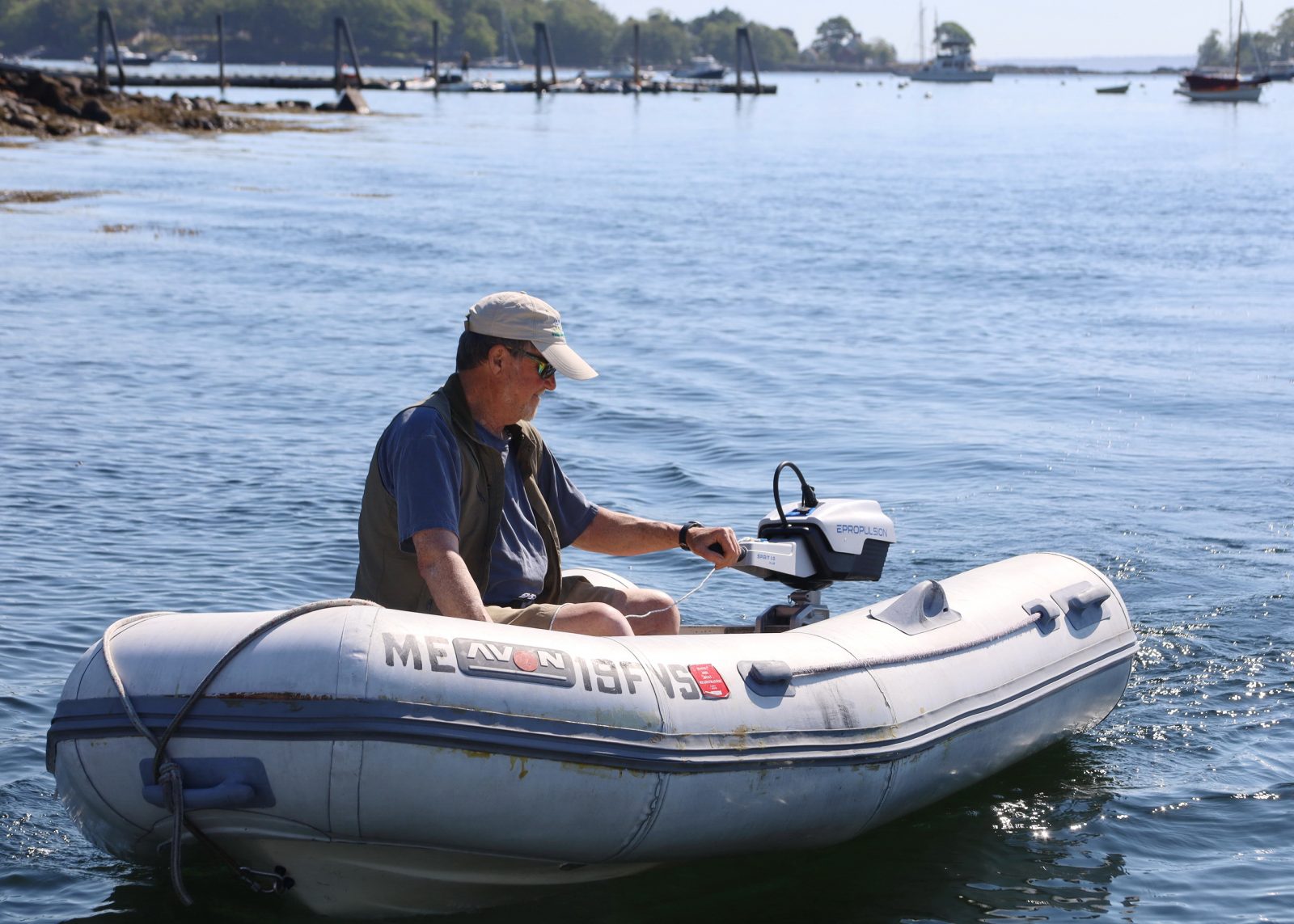
The summer of 2020 In my home harbor was different from past seasons in three ways: Superyachts owned by American billionaires were much more plentiful, far fewer than normal regular-size sail or power cruising vessels visited until about mid-August, and there were a whole lot more Torqeedo electric outboards in use on tenders and small boats. While the Covid pandemic clearly caused the first two situations, I think that the popularity of small electric outboards is just reaching a sharply upward and sustained growth curve.
But I only saw one similar-to-Torqeedo ePropulsion Spirit 1.0 Plus electric outboard in Camden this summer, and the fact that it belongs to my brother-in-law Richard Itkin — and hence I got to test it (as seen above) — is more than luck… and a story worth telling.
When we published the Spirit 1.0 Plus press release in early June, I was impressed with the motor’s design, value, and U.S. distribution setup. And I was still impressed after a long chat with Chris Ponnwitz, who leads ePropulsion U.S. east coast sales via Mack Boring’s longstanding network of marine service networks and boatbuilders. (For instance, they introduced Yanmar marine diesel engines to the U.S. in 1974, and remain the largest distributor.)
Just days later Rich called because his 20-year-old 8hp Yamaha dinghy outboard had finally bit the dust and he was wondering how well something like my beloved Torqeedo 1003 would work as a replacement. “Well, neither the 1003 nor their even better direct-drive Travel 1103C will ever get your Avon planing out to Brilliant, but…” And then I went on to list all the pluses of a lightweight, quiet, reliable e-outboard plus the interesting competition just introduced by ePropulsion.
But what really compelled Rich to immediately order a Spirit 1.0 Plus was the ePropulsion comparison document I had just received from Mack Boring, with permission to share.
You too can read In-Depth Comparison: Torqeedo Travel 1103C vs ePropulsion Spirit 1.0 Plus written by ePropulsion CEO Chandler Xu, and I think it’s a particularly good example of how a company can politely state their product’s competitive advantages in detail. But it’s no surprise that Xu finds his electric motor superior in almost every way, and it’s the astute consumer’s job to figure out what he may have left out of the comparison.
So I applied my skepticism to the written materials and then on the water to Rich’s actual Spirit 1.0 Plus, and it was great when along came Capt. Dan Pease, who retired from a salty marine career to avid cruising, two Torqeedo 1003 outboards included. Hence while Rich was bubbling with new owner enthusiasm, Dan and I were in “well, what can go wrong” mode. But we didn’t come up with much.
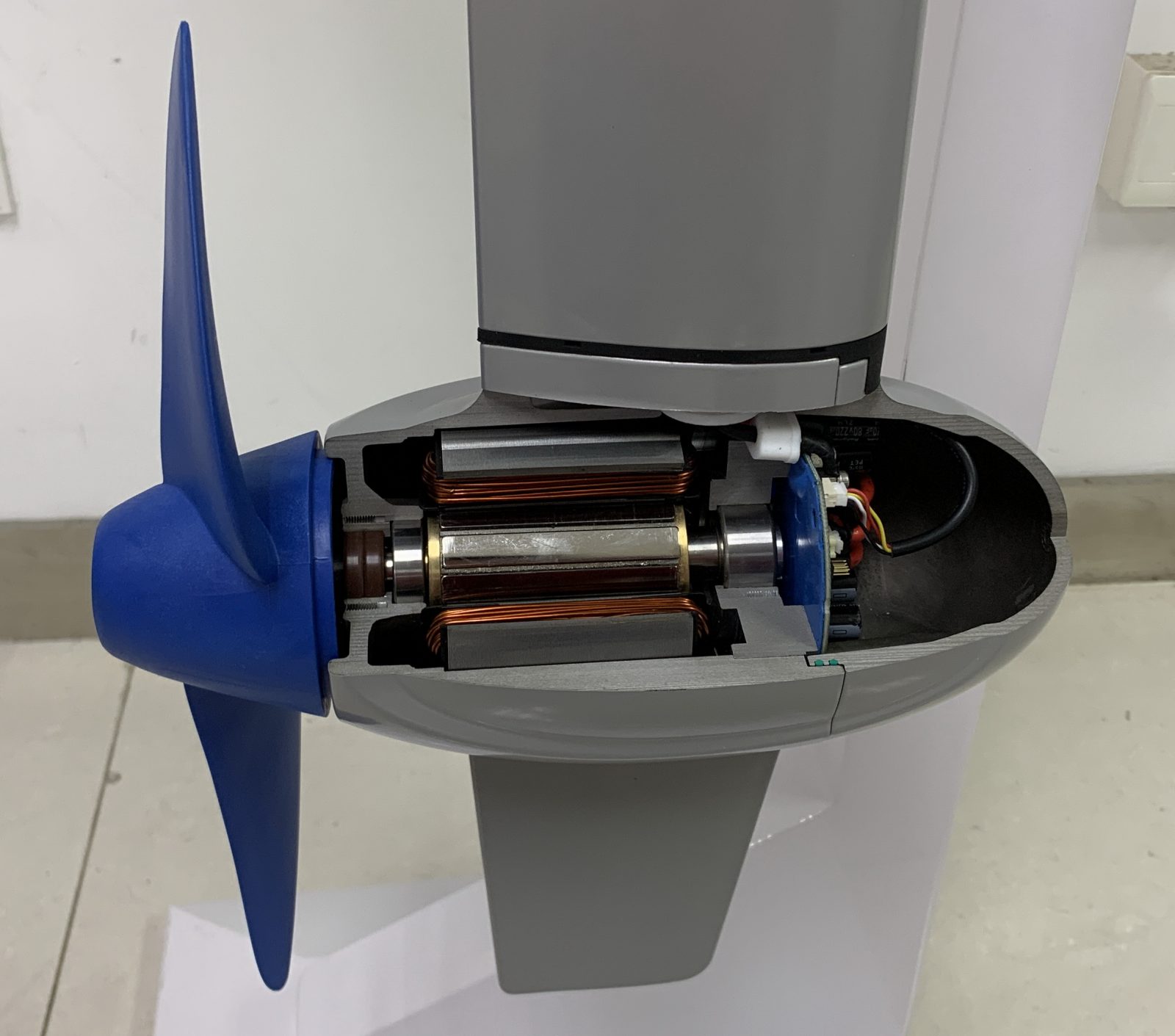
First though, we all experienced a “wow, that’s quiet” reaction. The Torqeedo 1003 models that Dan and I have used for years do produce a whirring noise because their motors are geared. The sound is not really a bother — especially compared to a gas outboard, or even this new Tahatsu 5hp propane model — but nearly complete silence underway is even better.
The Spirit is quiet because of the direct-drive brushless motor seen above, and it’s worth noting that the Torqeedo 1103C is also direct-drive. In fact, I tried one during a visit to Torqeedo headquarters near Lake Starnberg, Germany, in 2019, and the 1103 is not only super quiet but it also shifts between reverse, neutral, and forward more smoothly and quickly than the 1003, making for even better close-quarters maneuvering. The Spirit was similarly handy around a dock, plus I suspect that direct-drive motors will last longer just because they’re simpler.
But then again my test Torqeedo 1003 has not had any motor problems despite 10 seasons of saltwater use, many of those seasons very long and much of that time with the motor shaft in the underwater down position at a dock. And therein lies a large though understandably missing element in ePropulsion’s motor comparison. Torqeedo has developed and manufactured about 50% of all the marine electric propulsion systems on planet Earth, and has earned a mostly excellent reputation in the process. (In fact that 50% statistic is theirs, and I trust it.)
Which is not to say that Torqeedo products have been perfect. Hell no. Just skim through the 173 comments on my original Travel 1003 review for a history of grievances some owners have suffered (though they mostly seem resolved), and also recall that the 1003 was a major redesign of Torqeedo’s first electric outboard. This is a relatively new technology, small outboards often live a hard life, and it can be infuriating when they fail.
And those may be good reasons to spend extra money for the leading brand electric outboard. But then again, the Spirit 1.0 Plus at $2,000 retail is $700 less expensive than a Travel 1103C, and a bigger, faster-charging battery is among its pluses.
Getting back to the test session, I nearly laughed when I saw that the ePropulsion Spirit Plus has a dim and hard-to-read monitoring screen just like the Torqeedo Travel models. But there is a significant difference in what the dim screens deliver, because ePropulsion does not build a GPS into their system. So Rich will never see range in miles at current speed, but he does get current state of charge and time remaining at current load. (Or he can use the Select Button to see voltage instead of time remaining.)
I don’t think that the lack of GPS is a big deal, and after four months of frequent use Rich feels confident about the battery monitoring the Spirit does deliver, and has never suffered a dead battery surprise. But note the tiller folding instructions in the left photo, and that Dan and I both gasped a bit when we saw how that works. It’s true that the Spirit has one less cable to attach whenever you assemble the motor, but the hung-down tiller looks somewhat fragile when someone is moving it and rest of the outboard (less battery) around a small boat, or into a car trunk (or boat locker).
Also, Rich couldn’t tilt the Spirit all the way up on the stern of his Avon with the tiller folded down, or up (until he thought to spin it 180 degrees first). But then again, Chandler Xu apologizes for the limited tiller up motion in his motor comparison, and promises an improved design soon.
Which leaves my biggest question about what ePropulsion is doing, and I’m sorry to add that it remains unanswered. What you’re seeing in the cutaway Spirit Plus battery above is a stack of Lithium-polymer “pouch” cells, and I believe that’s unusual for this type of use. I do know, for instance, that Torqeedo Travel batteries contain 18650 style Lithium-ion cells as do all the ebike batteries I’m familiar with (and Tesla cars). And while Torqeedo politely declined to comment on the ePropulsion design, their battery page states:
Torqeedo only uses safety cells – welded steel cylinders each of which is equipped with multiple hardware safety mechanisms. Other forms of packaging such as foil-sealed cells (“coffee bags”) offer a lower standard of safety as they afford less effective protection against internal short circuiting within the cells.
Now to be clear, I know next to nothing about Lithium battery chemistries, packaging, and management systems, except that it’s very complex and dynamic tech. (Our friend Luis Soltero, for instance, is struggling to parse out what well-informed boaters should know about the various lithium marine battery variations like he did so well for lead-acid batteries.)
But I do know that even familiar 18650 style Li-ion battery packs can become quite dangerous in certain circumstances, and the relevant example is the 2019 Torqeedo Safety Warning along with the massive testing program that followed. With tens of thousands of Travel batteries in the field — mine for 8 years — Torqeedo discovered that the combination of a rare manufacturing error and at least partial battery submergence could eventually cause BMS corrosion and then maybe a spontaneous fire.
It’s my understanding that there were very few actual Torqeedo battery issues and that no one forced the company to spend gobs of money to ship batteries into testing centers around the world, where few bad ones were found. But founder/CEO Christoph Ballin was adamant about the safety initiative because the prospect of a rare but known issue causing , say, a battery fire in a storage locker aboard a vessel at sea was unacceptable.
I’m not sure that any other marine e-mobility company would have, or could have, handled this the way Torqeedo did. And while I really do not know if there’s any potential downside to ePropulsion’s seemingly unusual boat battery design, I’d like to know more, and I advise everyone to be thoughtful about how they treat and store whatever kind of large lithium battery they may own.
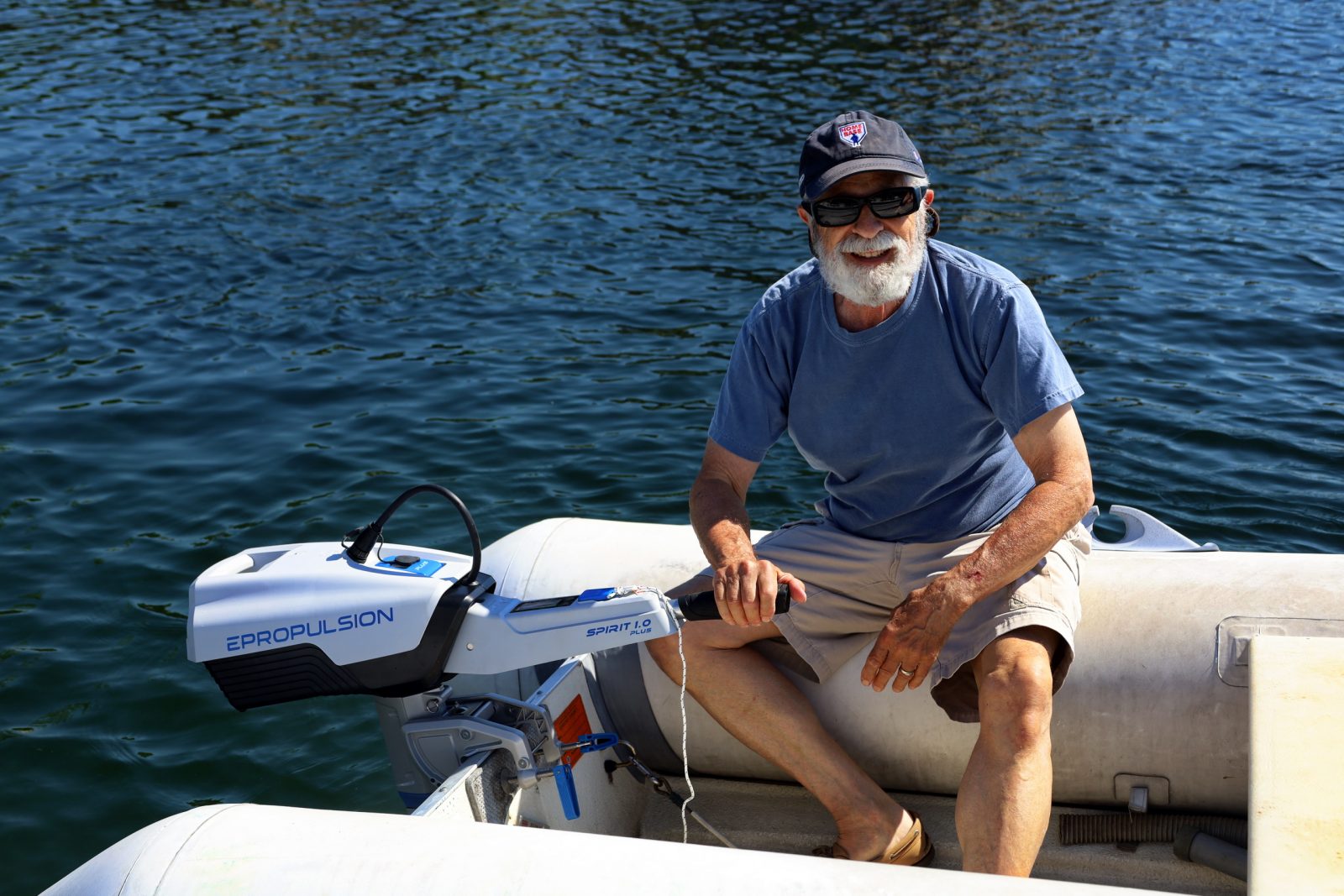
At any rate, there’s no denying the ePropulsion Spirit 1.0 Plus love felt by my brother-in-law Rich (who earned that “Capt.” caption a hard way). He’s learned to like the quiet so much that he often runs at half speed to avoid even hull noise, and that means lots of range with that relatively huge 1,276 Watt hour battery. Plus what a nice change it is to lift and store a two-piece outboard that doesn’t drip oil or gas (and the Spirit tiller has survived unscathed).
I think it’s great that Torqeedo now has compelling competition from ePropulsion, and I expect to see lots more electric outboards of both brands in seasons to come. Both companies, by the way, offer more outboard models than the equivalent 3hp type discussed here, and ePropulsion just announced E-Series Lithium Iron Phosphate batteries to extend motor run times or for other uses. Moreover, Ben Stein’s latest Panbo Podcast is an interesting conversation with Mack Boring’s Chris Ponnwitz where we also learn that seven new ePropulsion products will soon be announced.




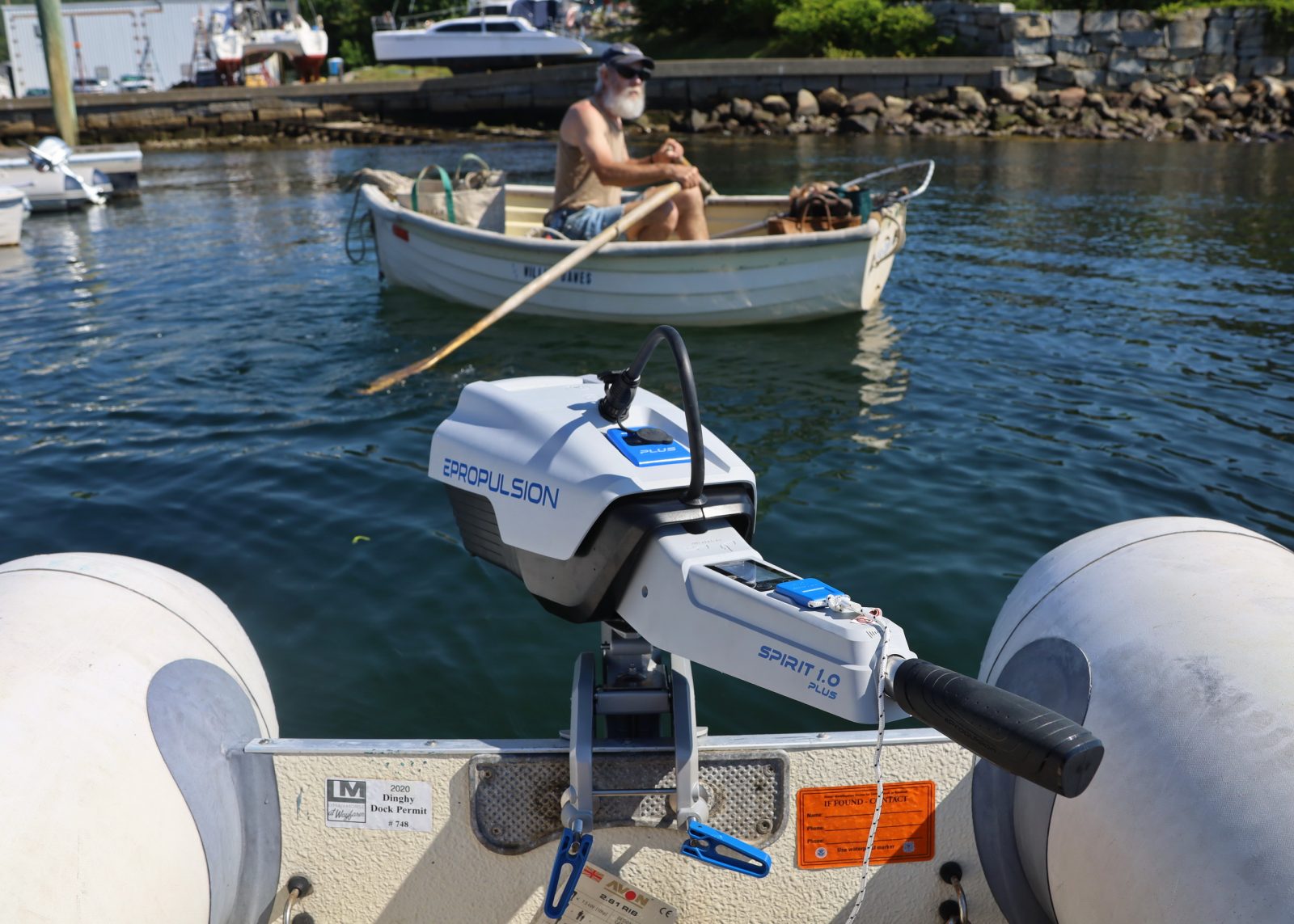


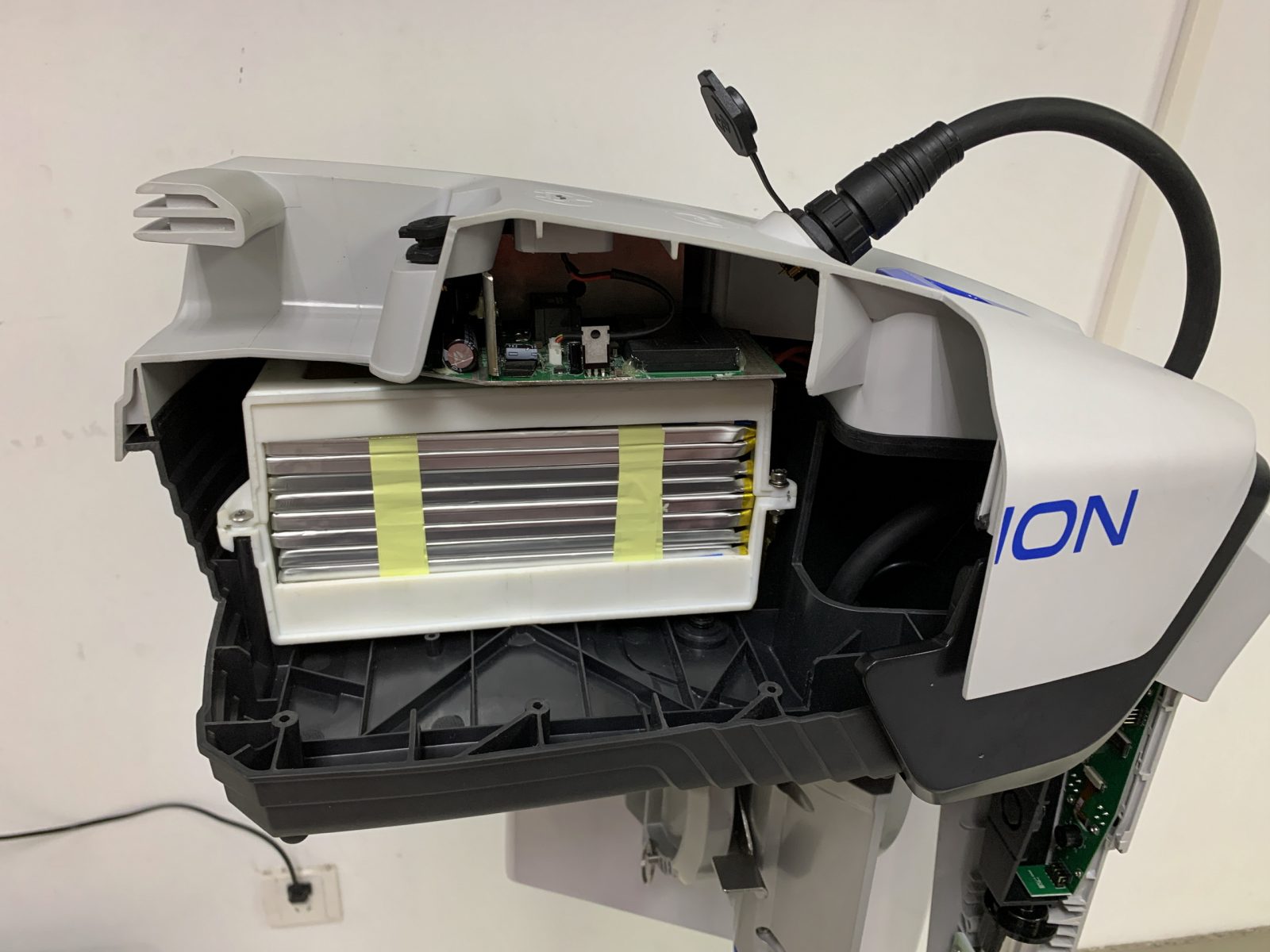



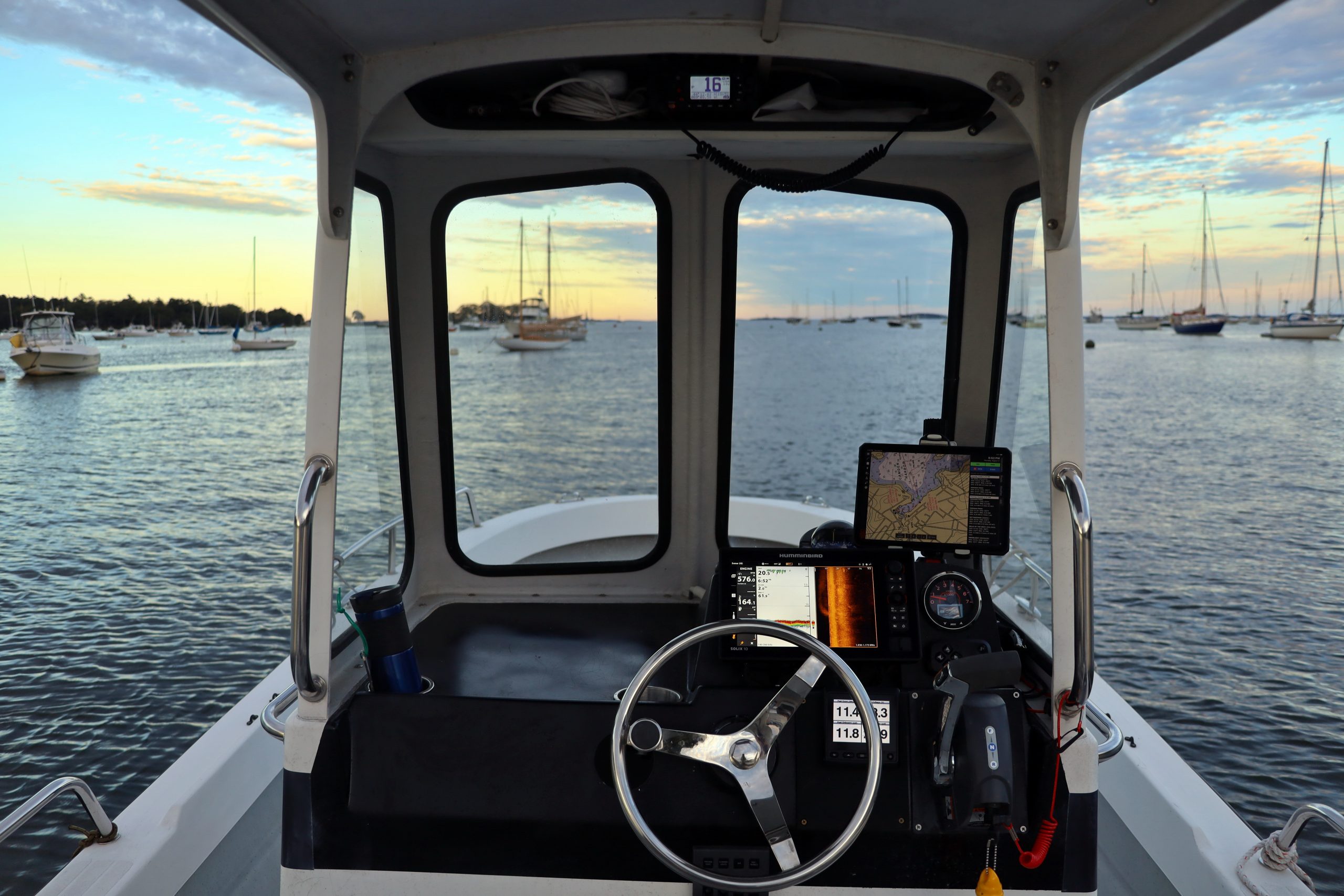







What type of speed/performance is it getting? I like the simplicity but I have a “10 foot” (west marine c310) dinghy and want to at least be able to happily beat currents etc. We have an old 2.5 hp motor, that doesn’t quite fill the need with wife/kid and me. Wife’s nervous about a new motor, cause she wants to make sure she can easily pull start, (I don’t want the weight/hassle of electric start)
I’m tempted to look at the bigger electric motors, and then just build my own battery packs, but I really like the convenience of these. But I don’t want to buy one and find 25% of the time, I need more motor.
Chris, The Spirit 1.0 Plus easily took Rich’s heavy old Avon to hull speed, and so did my old Torqeedo 1003. These electric outboards have amazing torque, even at low speeds, and I don’t think that any of the models discussed above would have trouble pushing your RIB against a current with a full family load. And if you look at the specs for two direct-drive models, they both have a little more static thrust than my 1003, which will push a small daysailer around.
These motors are not very good at high rpm planing but they are not really comparable to your gas 2.5hp in terms of torque. Plus electric starting is built-in 😉
Also, I think that Mack Boring is trying to set up dealers with “try before you buy” demo models, and Torqeedo may have similar.
Cool, well, once bottom paint and some sonar upgrades are done, we’re moving to a marina that’s listed as a torqeedo dealer. I did fill out the form on the Spirit page, but looks like it’s a gap of no dealers from Florida to Maryland with me right in the middle in NC. 🙁 Maybe we keep rocking the old mercury until we sail south. Thanks for the feedback and suggestions. I just wish they were cheaper. But that seems to be true of everything. 🙁
Ben,
My only complaint on my Torqeedo is the annoying delay I experience between throttle twist and motor response. Does the Spirit direct drive technology remedy this issue?
I guess I’ve gotten used to it, but certainly did notice faster response on the newer Torqeedo 1103C, and also the Spirit Plus.
My 1003 also had that annoying delay when moving the throttle off of the zero position. This was not helped any by the force that was necessary to turn the throttle off of the zero position. My passenger was often surprised when the rocket suddenly launched, and not surprised in a good way. ;-/ (I guess that’s one of the “benefits” of low end torque.) I don’t experience a noticeable delay with my 1103.
In my typical way, I did “hack” it to lessen the force necessary to turn the throttle. On the bottom side of the tiller there is a white plastic strip that presses against the throttle shaft and helps hold the shaft at the zero position. There are two screws that hold that plastic piece in place. Putting a SS washer under each of the screws, and a generous application of silicon grease, which lessened the holding force so that it’s very easy to slowly crack the throttle. And also achieve/maintain a supper slow speed for close quarters maneuvering. I applied this hack to my 1103 too and I’m really happy with the throttle now, as is Ms Passenger.
Now, if I could just remember which way is forward and reverse.
Mic, I’ve managed to get used to the delay – just crack the throttle and do a mental 2-count before cranking it up to cruise speed. I’m glad to hear others have a hard time remembering which way to turn – I even wrote on the control arm with a sharpie to help me remember!
Ours has loosened up significantly over the years, so not as bad as it was when new, but your fix does look useful.
Hi Ben, interesting as usual, and it’s good to see competition in the small electric outboard market. That “in-depth comparison” contains some rather hazy language (what does “…three capacity 2kWh, 4kWh, and 9kWh with $0.5 unit price.” mean?). But if they’ve improved the power connector, that’s good news – Torqueedo needs work in the connector realm for sure. I have cussed that plastic connector a LOT.
I do wonder, though – how does the performance compare? The Spirit claims a longer run time, but if it doesn’t go as fast, that’s a false comparison. You’d have to arrange to use one boat with both motors to make the comparison, of course 🙂 .
I can vouch for the low-end torque of the 1103 – it moves our Fatty Knees right along at VERY low throttle, and with surprising authority.
They’re talking about a retail price of about $0.50 per Watt hour capacity, and it is worth bragging about. The vaguely similar 3,500 Wh Torqeedo battery retails for $3,000, or $0.86 per Wh.
But then again the nominal 25.2v Power 24-3500 — https://www.torqeedo.com/us/en-us/products/batteries/power-24-3500-/2106-00.html — can be used for house power as well as integrating with a Torqeedo Cruise outboard, and I’m not sure that ePropulsion’s $2,000 nominal 51.2v 4,096 Wh E80 battery can be used for anything beyond the motors:
https://www.epropulsion.com/e-series-batteries
Also the E80 weighs 106 lbs while the 24-3500 is only 56, and the E80 claims a battery life of 3,000 cycles at 80% Depth of Discharge while Torqeedo specs the 24-3500 as expected to lose 25% capacity after “800 cycles with 100% discharge depth at 25°C.” In short, the specs are sometimes hard to compare, but they seem like quite dissimilar battery technologies.
Hi Ben, yes, that would explain that comment, though the “run time” brag remains unverified. And I don’t know why I wrote we had an 1103 – we still have our faithful 1003 🙂 It didn’t get much use this past summer 🙁
Thanks, Enjoyable as always
A few thoughts for those choosing between the 1103 and the Spirit 1.0+…
For perspective, I owned a 1003 for 3 years and now own a 1103 since Feb.2020. I’ve looked at the Spirit 1.0+ and yes, there are many things to like about it: A bigger battery and shorter recharge time are chief among them. And a floating battery! I live in fear of accidentally dropping the Travel battery overboard. That would be an expensive mistake and having no working outboard for the dinghy could also impact cruising plans. A tether solves that problem but it is a bit of a hassle.
The Spirit’s integrated battery latch is an obviously superior feature; one less thing to lose. The robust SS quarter turn barrel connector on the motor is also a BIG plus. I like the “idea” of the attached tiller, in as much as it would facilitate a two handed carry down the dock. However, my outboard lives on the boat so the need for a one-person carry is very minimal, and I have the carry bag for that. When leaving my dinghy at a beach or a strange dock I like to put my Travel’s tiller in my day-pack during shore trips for a little more peace-of-mind than taking the kill-switch magnet provides. I leave the outboard mounted during the cruising season so not leaving the tiller (and its electronics) exposed to the elements 24/7 also gives me some peace-of-mind. I just wish that Torqeedo would provide a weather proof cover for the tiller connector that’s on the battery. I like knowing my speed as provided by the Travel’s GPS, but it is not essential. I am really impressed that ePropulsion is already responding to user feedback by improving the tiller design. Speaking of design, the Spirit is a more modern and attractive design from an industrial design perspective, IMHO.
My 2 Travel outboards have been very reliable (Although that’s only a sample size of 2) When thinking about reliability, consider years in production, number of units in the field, user’s experience and the factory’s response to problems. I’m curious to see what Spirit users have to say.
The Spirit looks like a very well engineered unit at a competitive price. It’s great to see another strong contender in this space. I look forward to further advances in electric outboards that this competition could provide.
Thanks, Mic. I’m told by knowledgeable friends that Travel batteries do not sink fast, and neither does the whole motor assembly. (Actually, that’s the same unfortunate friend!)
So you may have a chance to nab one before it gets too far, but if you fail, it may travel quite a ways before settling on the bottom 😉
A traveling Travel battery! Haha.
Nice to know, if it comes to that. Regardless, I’ll do my best to avoid conducting any of my own settling distance tests.
Cool! The great small boat video site OffCenterHarbor.com just debuted a thorough review of the IP Carry, a smaller lighter electric outboard with several interesting design features not seen in the motors above:
https://www.offcenterharbor.com/videos/sail-oar-camp-cruising-part-2-sail-more-electric-motor-ep-carry-review/
I’ve had an EP Carry for two seasons – it’s wonderful. My wife loves puttering around harbors in the dink (Achilles LSI-88 8’8″ air deck). And the grandkids quickly took to running it as well, even the (then) 4yo. The EP Carry is made near me so I was able to spend upwards of an hour (pre Covid!) with the creator – he demo’d things like jamming the propeller with a thick stick while running at full throttle (built in resistance sensors immediately cut power with zero damage) and showed one that’s been left un-tilted into salt water for more than a year with no effect. And I’m sold on the LiFePO4 battery with none of the limited life characteristics of the Torqueda’s older technology.
Thanks, Keith. The EP Carry tilt and drop system seems very slick, as well illustrated in the OCH video. And the little motor is pushing a pretty big boat, though the videographer Steve Stone says it won’t do much against about 15kn wind. Also, I think that the 24v 9.6 Ah EP Carry battery works out to 230 Wh, versus the stock Torqeedo 1103 battery at 915 Wh and the Spirit 1.0 Plus at 1,276.
Yes, I want that brilliant tilt mechanism. That is something to be emulated and improved upon. I always struggle a bit to get the motor tilted up before hitting the beach. Leaning back to grab the back of the motor and lifting is awkward at best, especially with all the other things you have to manage when beaching.
Also, the auto-stop feature seems very worthwhile. I’ve destroyed one Travel prop when I hit a rock (at low speed) and the drive pin tore up the prop’s hub. We were up in AK and had to get a new prop flown in. Ugh. (Tip: I carry a spare prop now)
Let me throw out another couple of thoughts for anyone considering switching to an electric outboard, a benefit that had not occurred to me until I’d experienced it.
I have a good friend who is a pro-grade amateur nature photographer. Myself, I’m definitely in the low amateur ranks. And even if not photographing I really enjoy getting up close with nature. As soon as we drop the anchor we’ll go “hunting” for wildlife. We have been amazed at how close we have been able approach wildlife without disturbing them. The direct drive motor is soooo quiet and the low speed torque gives you great drift control. You can be sitting in your dinghy absolutely still and quiet and still position yourself for the perfect shot.
A similar thing could be said for slow trolling an area for fish and then hovering over a hot spot when you find it, all without the noisy smelliness of a gas outboard.
I have loved my e-Propulsion motor for two seasons. It has worked flawlessly. My only regret is buying two batteries as I have never found that I need the second one. I power both my 19’ Flying Scot sailboat and the inflatable tender on my big boat. It powers both with aplomb. On the FS I can ghost along silently with all sails set powering through lulls between puffs. It has given new enjoyment to those still summer evening harbor cruises. Best of all it is silent. No noise. Also safe, no gas cans to store aboard. No oil mess. I don’t need those bombs on my sloop. This gets me where I need to go I just cannot waterski on the way. That’s ok by me.
Tried to contact them… didn’t work with two browsers. Tried to get a dealer to call…. nothing. I don’t know why manufactuers won’t disclose better contact info.
I can imagine what warranty would be like.
Oh well, I’ll just stay with gas.
I’m happy to see more competition in this space. I think I have said this before but I will say it again, I’m a bit amazed motor guide or minn kota has yet to try and compete in this space. They have a good basis for a design, some more efficient motors (like what Garmin and Lowerence recently released) controls and props for non trolling motor application would seem to be what is required.
They do offer some pontoon boat motors but I’m unsure why not go into general purpose small outboards.
I finally found a dealer to email to get additional info. I’d love to switch to electric, but have concerns about performance and warranty/parts.
They say it will go wide open for an hour, but 4 hours at cruising speed. Is cruising speed on plane?
Any comments from users?
Also on the batteries. I think the Nissan Leaf and Chevy Bolt both use or used pouch cells, and I think BMW uses prismatic, so it seems EV builders are using all three. I don’t know how that shakes out in the real world thou.
You may find this ebm from Austria interesting:
http://aquamot.at/en/produkte/trend-line/neu-aquamot-trend-1-3-1-8/
Bought the epropulsion 2 years ago as I had issues with my last 2 gas outboards. I was skeptical at first but saw it at a trade show and got a discount for being one of the first to buy in Southern California. I use it on my tender a Zodiac 270 Cadet. It runs great, no issues. Always starts, great thrust, better consistent power with no dead spots like my Tohatsu. Recently, we added second battery and a high speed charger for picking up Lobster traps. We could use a full charge at various rpm for about 5 hours. We didn’t need to use the second battery, but it’s nice to have a second battery in case we run out. Concerned about what I’m reading here about lithium ion battery potential for spontaneous fires, and would like to hear more of this if anyone has some information .
Don’t be worried about fires. While it can happen, usually its from serious mishandling or poor charging. IF you ever see lithium batteries getting puffy though, IMMEDIATELY stop using it and find somewhere to discard safely. I have seen lithium puff and explode, (rc racing, usually pulling insane amps from too small a battery) but its from being dumb. Gasoline can explode as well. 😉
Thanks! I will feel safer now. I will not go back to gasoline powered dinghy tenders,
The torque and consistency is worth the charging inconvenience.
Lithium batteries are vulnerable to a thermal runaway condition that can cause an explosion or fire, but modern technology with smart regulators on each cell have made them pretty safe, absent some sort of physical trauma that disrupts the cell itself. You DON’T want to be anywhere near a lithium battery that has been ruptured or crushed (which is why they don’t want you to simply discard your old cellfone & laptop batteries,) I don’t know about the ePropulsion batteries, but our Torqueedo 1003 batteries are in pretty rugged cases, and the regulators are inside, so even careless charging does not create a risk, IMHO.
Thank you for your thoughts on this.
I’ve had an ePropulsion Spirit 1.0 for three seasons (and during each of those seasons it’s made an appearance in Camden Harbor). I have no complaints whatsoever about it — it’s been faultless.
What I like best: 1) storage (simply throw it in a cockpit locker in any orientation); 2) no gasoline on board; 3) quiet.
One consideration is that fully charging the 1200 Wh battery will take 100 Ah out of a 12v battery system
The info about 100AH to recharge is very useful. Thank you.
DOES ANYONE KNOW IF AN ATTACHED 12 VOLT BATTERY THROUGH THE SOLAR CHARGER CAN MAINTAIN ANY RPM TO GET HOME WITH E MOTOR.
IT DOES SAY IT CAN CHARGE WHILE RUNNING AND HAS A LIGHTER PLUG ON SOLAR CONTROLLER
Hi Barney, It does look like the Spirit Solar Charger can step up a 12v feed to work with the nominal 40v Spirit batteries, but I’d check with a dealer or ePropulsion to be sure:
https://www.epropulsion.com/product-page/spirit-solar-charger
As for powering the motor directly from solar panels, I’m a little dubious but certainly depends on size of panel and intensity of sunlight.
Thanks much for the fantastic write up. I am considering one of these two outboard options for a 12 feet mini tugboat I am building. I am attempting to not cause unintentional damage by hanging the motor off transom, and was looking at an extension cable option to separate the battery unit.. did you have a chance to explore this option and which of these two would work in such a configuration ? Thank you
Hi Sandeep, Did you see my entry about the Temo electric drive?
https://panbo.com/temo-unique-electric-propulsion-with-ancient-design-roots/
Also, is there anywhere online where we can see more about your mini tug design, like where you’ll be when driving and what things look like from there to the stern?
Do you know if it’s possible to feed the power from the Spirit 1.0 hydro generator into a yacht’s battery system? 40W at 4kts (300w at 10kts) would certainly keep the autopilot going when long-distance cruising… but are there leads available to get the power from the Spirit 1.0 to the yacht’s battery charger?
Well, it’s possible to use the Spirit Evo with ePropulsion’s larger lithium batteries, or even third party batteries, but the bank has to be 48v. So, yes, there is a cable system available, and remote controls, but you’d probably have to do some DC-DC conversions to work with your yacht system. More detail shown in the new Spirit 1.0 Evo manuals here:
https://www.epropulsion.com/download/
Great answer – many thanks!
I know this is old, but does anybody have thoughts on using this to power a small 18″ pontoon boat? We’re on an electric only tiny lake and use our pontoon as a floating dock of sorts. No need for speed at all. Right now we use a 55lb trust trolling motor and it struggles on the highest speed, against a small wind. I dont want to throw down $4k and up for an electric outboard just yet.
Well, I’m dubious that the 1,000W — approx 3 hp equivalent — Spirit Plus could push your pontoon boat in a serious breeze, but I also think that it would have a LOT more torque than the 55lb thrust trolling motor. ePropulsion doesn’t specify thrust numbers for its various models, but maybe that’s because they don’t necessarily indicate real world push or speed abilities. For instance, note this claim:
“In fact, Spirit 1.0 with static thrust 71 lbs can go faster than Minn Kota Riptide Ulterra with static thrust 112 lbs on the same boat.”
https://www.epropulsion.com/post/electric-outboard-vs-trolling-motor/